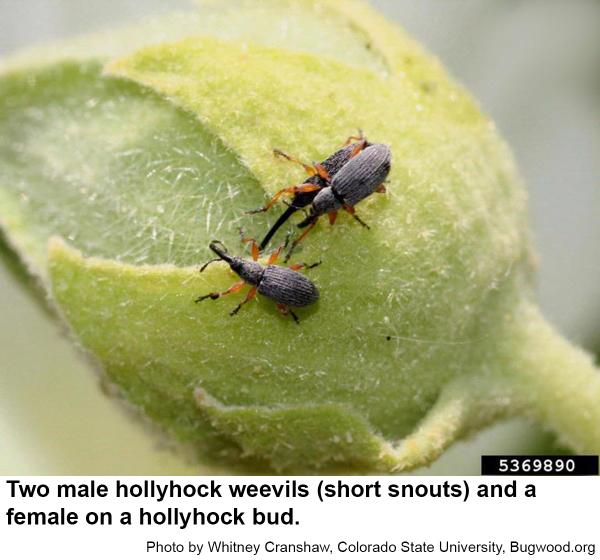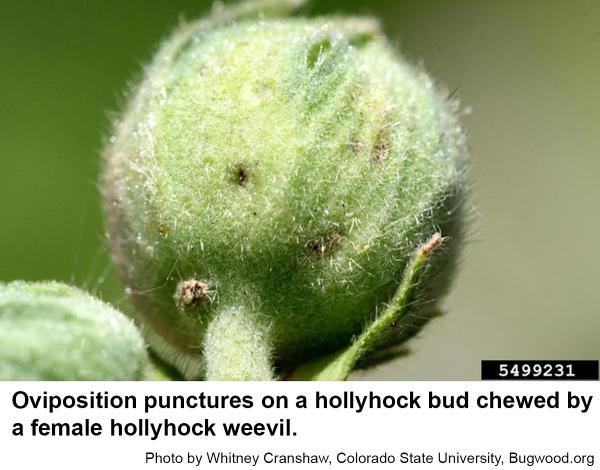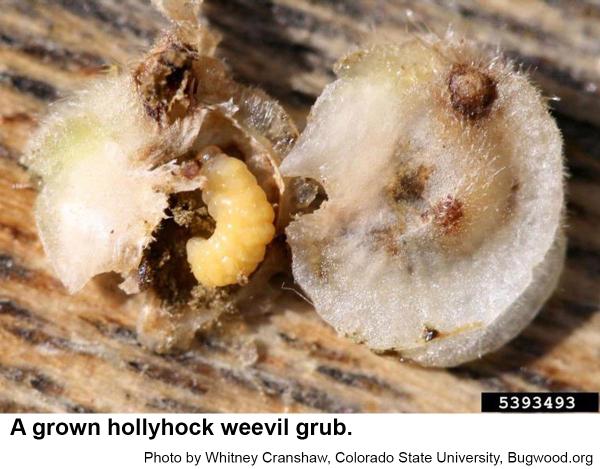Description and Biology
The hollyhock weevil, Rhopalapion longirostre, is a tiny, black beetle with tannish to orange legs and mouthparts located at the tip of a long beak or snout. Including the snout, females are about 1/4 inch long and males about 1/8 inch. Female hollyhock weevils have snouts almost as long as the rest of the body! These weevils eat small holes in buds and leaves of hollyhock in June and July. Such injury resembles flea beetle injury to egg plant or tomato. Heavily infested leaves have a lacy appearance. As soon as flower buds develop, hollyhock weevils climb up and congregate on buds, flowers, and seed pods. Female weevils chew holes deep into the seed pods and lay eggs in or on developing seed pods of hollyhock or at the base of sepals. Very tiny larvae hatch three or so days later. These larvae are typical weevil grubs with white, legless bodies and brown heads. The larvae feed between sepals and seed pods or feed on a seed inside the pods. Eventually the grubs develop fully and pupate. Some time later, a new generation of weevils emerges from the pupal stage to complete their cycle. New adults apparently feed on remaining seeds. Hollyhock weevils usually spend the winter as adults near previously infested hollyhocks although some grubs developing late in the season may winter within seed pods and pupate the following spring. In spring the adults move to growing hollyhock plants where they feed on buds, tender stems and emerging leaves. We have one generation per year in North Carolina.
Host Plant
Hollyhock seems to be the only host of the hollyhock weevil.
Residential Recommendations
Hollyhock weevils feed at night and readily drop from the plant when disturbed. By carefully placing a piece of fabric under a plant and then shaking it, the weevils will drop down where they can be collected and put in some soapy water to die. The hollyhock weevil is not reported to be resistant to pesticides. Sevin or other insecticides labeled for landscape use should give more than adequate control of adults hollyhock weevils. These pesticides should be available in most garden shops and plant centers. Don't spray open flowers as pollinators may thereby be harmed.
References
- Hollyhock Weevil. Anonymous. No Date. Colorado Insect of Interest.
- Hollyhock Weevils Cause Reduced Flowering. Patterson, R. 2011. Utah Pest News, Utah Plant Pest Diagnostic Lab & USU Extension.
- Life history and control of Apion longirostre Olivier. Tattershall, J. T. and R. H. Davidson. 1954. Journal of Economic Entomology, 47(1): 181-182.
- Extension Plant Pathology Publications and Factsheets
- Horticultural Science Publications
- North Carolina Agricultural Chemicals Manual
For assistance with a specific problem, contact your local Cooperative Extension Center.
This Factsheet has not been peer reviewed.
Publication date: Aug. 10, 2016
Reviewed/Revised: Sept. 24, 2019
Recommendations for the use of agricultural chemicals are included in this publication as a convenience to the reader. The use of brand names and any mention or listing of commercial products or services in this publication does not imply endorsement by NC State University or N.C. A&T State University nor discrimination against similar products or services not mentioned. Individuals who use agricultural chemicals are responsible for ensuring that the intended use complies with current regulations and conforms to the product label. Be sure to obtain current information about usage regulations and examine a current product label before applying any chemical. For assistance, contact your local N.C. Cooperative Extension county center.
N.C. Cooperative Extension prohibits discrimination and harassment regardless of age, color, disability, family and marital status, gender identity, national origin, political beliefs, race, religion, sex (including pregnancy), sexual orientation and veteran status.






